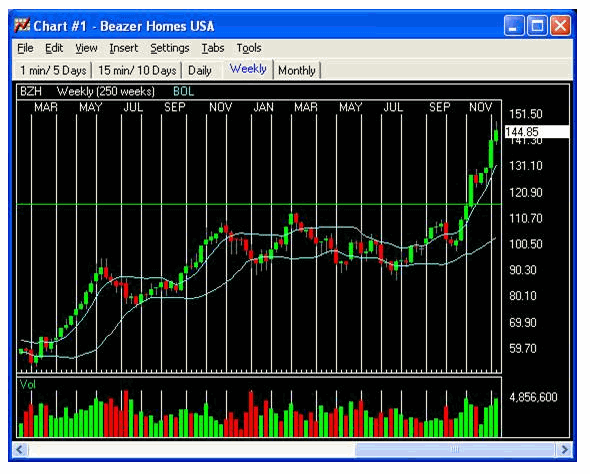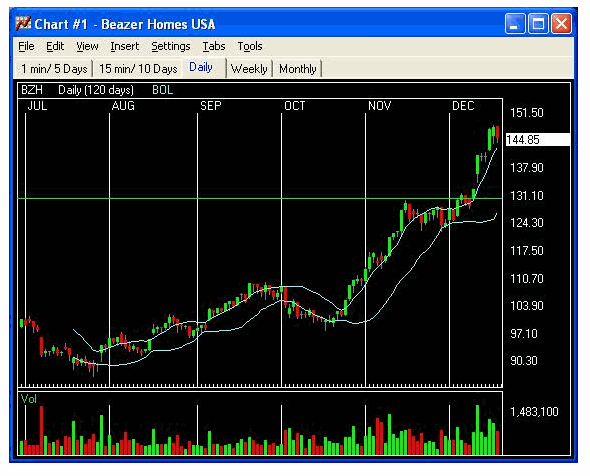How I Rode BZH from 116 to 145
My favorite trade is actually one I outlined in
my book, The Essentials of Trading, in the discussion of the primary
methodology I use for stock trading. I’ve had trades that have made more money,
or produced higher percentage returns, but few were quite so satisfying.
In late October or early November of 2004 I went long Beazer Homes
(
BZH |
Quote |
Chart |
News |
PowerRating), a
company in the business of home building. As you can see from the chart below,
the stock had just broken through some important resistance going back to early
in the year after a long period of consolidation.

There isn’t the space here to go in to the full explanation of my stock system.
Suffice it to say that I look for a combination of fundamental, technical, and
quantitative factors. In the case of BZH the company’s earnings were
outstanding. The market was valuing the shares at somewhere around 7 times
forward looking earnings, which made the stock a massive bargain at it’s
significant earnings growth rate of the time.
This trade took place at a time of extreme public pessimism about the housing
market. Every news report seemed to talk about how there was a bubble forming in
the real estate market and that it was about to burst because rates were heading
higher. So here I had a clearly undervalued stock breaking out to new highs in
the face of a pessimistic public outlook. What a perfect situation!
I actually didn’t buy BZH shares. Instead I decided to work in the options
market. I bought the February 115 calls at $9.10. I chose the options route
because it was the most cost effective way for me to trade BZH given the price
of the stock ($116) and my desire to have a few other positions on as well.
Plus, the options provide a fixed downside risk.
As you can see in the chart below, BZH took off from my entry point:

The initial set up aside, one of my other reasons for liking the BZH trade is
how it created a nice continuation pattern in late November from which it broke
out again strongly in December. It was never a nerve-wracking period, and in the
end provide a nice point to add to long positions.
I used a rolling strategy with my options position. As noted, I started with the
February 115 calls. When BZH reached 130 I rolled my position up in strike,
exiting the 115s at about $18 and buying the 130s at $8.60. In doing so I was
able to not only take better than $9 out, but also lower my exposure in doing
so. I repeated this process at 145, doing almost exactly the same thing in terms
of the selling and purchase prices for exiting the 130s and entering the 145s.
In February of 2005, BZH topped out at about 180 (it split 3 for 1 shortly
thereafter), before pulling back. It actually got up to around 240 on a
split-adjusted basis early this year. So much for the housing bubble!
I’m not going to sit here and say I rode the stock for that whole rally. I wish
I had, but I got out in early 2005. It may be that I left a few bucks on the
table, but I was very satisfied with the trade and the way I handled it. Really,
that’s what every trader should be shooting for with every position taken. We
aren’t going to profit each time, so we have to focus on doing things the right
way.
John Forman
